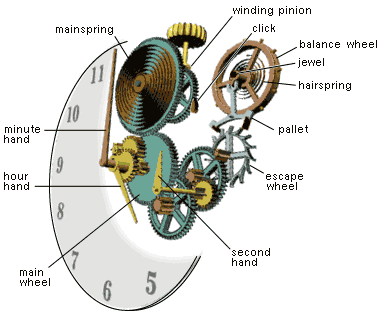Classic Mechanical Clocks
Most of the modern clocks now utilize these next few methods for keeping time. All but the quartz watchs use a device known as an escape mechanism. This escape mechanism serves a very inportant purpose because it regulates the forces applied to turn the clock gears in such a way that they move only a certain amount per second. I will give a brief overview of the physics behind escape mechanism but for a very in depth look into their function and how to design your very own I would recommend reading the "Clock Escape Mechanisms" link to the right, it is very insightful and readable.
The escape mechanism works by transfering the force driving the gears to turn (whether it that force is caused by trasfering the gravitational force from a weight or the force transformed from battery power) into an oscillating mechanism which could be in the form of a pendulum, a spring, or a verge-and-foliot. Each oscillating mechanism has its own frequency of oscillation and period of movement which are used to determine the amount of time each oscillation takes. The oscillating pieces work as the clock's counting mechanism and through the use of gears - or in the case of digital watches electronics - the clock is able to keep accurate time.
Spring Loaded
(picture source)
The way a spring loaded clock works is that it utilizes the potential energy stored in a wound spring to turn gears that are then stopped and restarted by the escape mechanism which makes the movements of the watches hands move at a certain rate. The main disadvantage with this type of design is that when the wound spring starts to get to the end of its potential energy store the periodicity of the second hand slows down until the spring is wound back up. One of the main advantages of this style over one with a verge-and-foliot escape mechanism is that this clock has a spring in its escape wheel which gives the escape mechanism a specific oscillation rate.
Pendulum / Weight Power
(picture source)
The pendulum/weight design utilizes the potential energy from a hanging weight to turn its gears and a pendulum assisted escape mechanism to give the clock a certain periodicity. Just like the spring in the assisted escape wheel a pendulum has a specific frequency at which it travels which aids in the accuracy of the clock. But unlike the spring loaded clock, a weight driven mechanism keeps more accurate time because it faces less error when the weight gets close to needing to be reset.
More Modern Clocks
Quartz Vibrations

The main difference in a quartz watch to the previous clocks is that instead of using a pendulum of spring assisted escape mechanism the wacth uses the natural oscillations in a piece of quartz that has electricity flowing through it. The oscillations inherent in the quartz actually give the watch an accuracy that is close to one second in ten years. While this is very accurate, it is not accurate enough for the length of a second to actually be defined by. The quartz watch ustilizes the oscillations of the quartz crystal to oscillate the magnitism in a magnet which cause it to turn. This turning is transfered into turning other gears that then display the time on the front of the watch.
Most digital watches utilize quartzs as their time keeping mechanism as well but instead of gears the oscillations are transferred into code which counts and displays the count in terms of the time. But recently a new clock that uses the oscillations of atoms has been invented which is the most accurate clock of all and it is called the atomic clock.